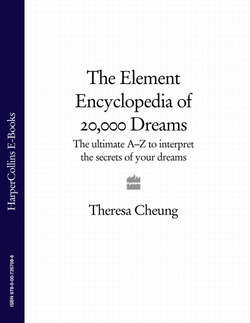Читать книгу The Element Encyclopedia of 20,000 Dreams: The Ultimate A–Z to Interpret the Secrets of Your Dreams - Theresa Cheung, Theresa Cheung - Страница 10
A Brief History of Dream Interpretation
Оглавление‘Now Allah has created the dream not only as a means of guidance and instruction, I refer to the dream, but he has made it a window on the World of the Unseen.’ Mohammed, the Prophet
Ancient art and literature are crowded with references to dreams. For thousands of years dreams have been credited with supernatural or prophetic significance by the majority of the world’s spiritual traditions. The Bible, for instance, makes it clear that dreams are divine messages and this explanation for dreams was shared by the ancient Egyptians, Greeks and Romans, all of whom also believed that dreams had healing powers.
Certain cultures, such as the Australian Aborigines and many African and Native American tribes, have always believed dreaming to be a way in which an individual can enter into the collective spirit memory. To this day, dream pooling plays an important role in those societies where tribal members gather together for the purpose of interpreting dreams. Another view is held by the Inuit of Hudson Bay in Canada, who believe that when a person falls asleep and dreams, their soul goes wandering.
The Egyptians are thought to have been the first to develop a system of contrary dream interpretation; a positive dream, for example, predicts misfortune and a nightmare predicts an improvement in waking fortunes. They produced the earliest known dream dictionary, written approximately 4,000 years ago. Now called the Chester Beatty Papyrus, it came from Thebes in Egypt and is kept in the British Museum.
It was the ancient Greeks, however, who first proposed the theory that dreams were not from some external, divine source but internal communications, or the divine spark within. Plato (427-347 BC) suggested that dreams were expressions of a person’s hidden desires, whilst his pupil Aristotle (384-322 BC) speculated that dreams shared similar themes and were not divine oracles but coincidences. It was the ‘father of medicine’ Hippocrates (460-377 BC) who proposed that dream symbols reflect the state of the dreamer’s body—for example, fire denoted indigestion—and should be regarded as valuable diagnostic tools.
The first fully-fledged dream researcher to focus on dream symbols and dream themes was a Roman living in Greek Asia Minor called Artemidorus (AD 138-180), who wrote a book about dream interpretation that is still in print. As far as Artemidorus was concerned, dream symbols had certain meanings but the most important aspect of dream interpretation was the symbols’ personal significance to the dreamer, along with the dreamer’s personal circumstances.
In much of Europe, even though the early Christians respected dreams for their spiritual significance, the repressive control of the Roman Catholic Church put a stop to any attempts at dream interpretation. By the fifteenth century, dreams were regarded as no longer significant or important. Even a century or so later, Shakespeare called them ‘children of the idle brain’. This school of thought persisted into the eighteenth century, when dreams were still thought to be meaningless.
In the early nineteenth century, when the restrictive influence of the Church began to wane and members of the German Romantic movement—in their quest for spontaneous expression—rediscovered the potential of dreams, a revival of interest in dream interpretation began to trickle into the mainstream with the publication of popular dream dictionaries such as Raphael’s Royal Book of Dreams (1830). The stage was now set for Freud and Jung; two men who continue to have the greatest impact on the way we interpret dreams today.
